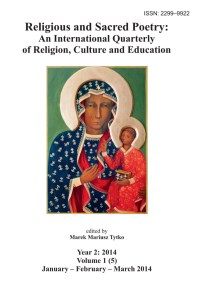De-Clawing the Christian Horace: The Suppression of Sarbievius’ Roman Catholicism by His British Translators
De-Clawing the Christian Horace: The Suppression of Sarbievius’ Roman Catholicism by His British Translators
Author(s): Charles Stephen KraszewskiPublished by: Fundacja Naukowa Katolików »Eschaton«
Keywords: Maciej Kazimierz Sarbiewski (1595-1640); Matthias Casimirus Sarbievius (1595- 1640); Motiejus Kazimieras Sarbievijus (1595-1640); Casimir Britannicus (1595- 1640); Mathias Casimirus Sarbiewski (1595-1640); Sarbievius (1595-1640); Casimir (1595-1640)
Summary/Abstract: Comparative / explicative analysis of G. Hil’s English translations of the Latin poems of Maciej Kazimierz Sarbiewski (Sarbievius). The thesis of the article is as follows: Sarbiewski (Sarbievius), a Jesuit priest and neo-Latin poet, was arguably the most visible and influential neo-Latin poet of Baroque Europe. Widely published throughout Europe, he was also translated into many vulgar tongues, including English. The one published translation into English which takes most account of the widest range of Sarbiewski’s work is Odes of Casimir by G. Hils. Given the anti-Catholic animus obtaining in England at the time, it is striking that the works of a Jesuit priest could pass the government imprimatur. The article proves that, in order to do this, Hils resorted not only to completely masking the Catholic, not to say Jesuit, character of the author (palpable in the poems themselves), but also masking his traces by, in some instances, revising the Latin originals printed side by side with the translations. In so doing, Hils not only shows himself to be a cavalier translator, he shows himself to be a dishonest editor who does violence to another author’s intellectual property. The author of the article used a comparative method (comparing the translations to the originals) as well as explications de texte (close readings) of both the original Latin, and translated English, poems. Main results: A cogent comparison of translations based on concrete examples, which also has ramifications for the ethics of translation in general. The results are limited to one translator. It would be interesting to see if such “masking” of the author was carried out on a wider scale in Baroque Britain. Practical implications of the article. The results of the analysis can be applied to practical didactics: i.e. the teaching of British literature, Polish literature, neo-Latin literature or literature in general; they also might lie in the area of translation theory, cultural transfer, and the ethics of translation/interpretation. Social implications of the article: The rights (or lack thereof) of translators to heavily skew the texts they are interested in, so as to make their work more acceptable to the powers that be, or more reflective of their own concerns and beliefs. The novelty of the article resides in the fact that until now no one has conducted a thorough evaluation of Hils’ work. Up until now, their “quality” has been unquestioned; this article proves just how faulty they are.
Journal: Religious and Sacred Poetry: An International Quarterly of Religion, Culture and Education
- Issue Year: 2014
- Issue No: 1
- Page Range: 61-78
- Page Count: 18

